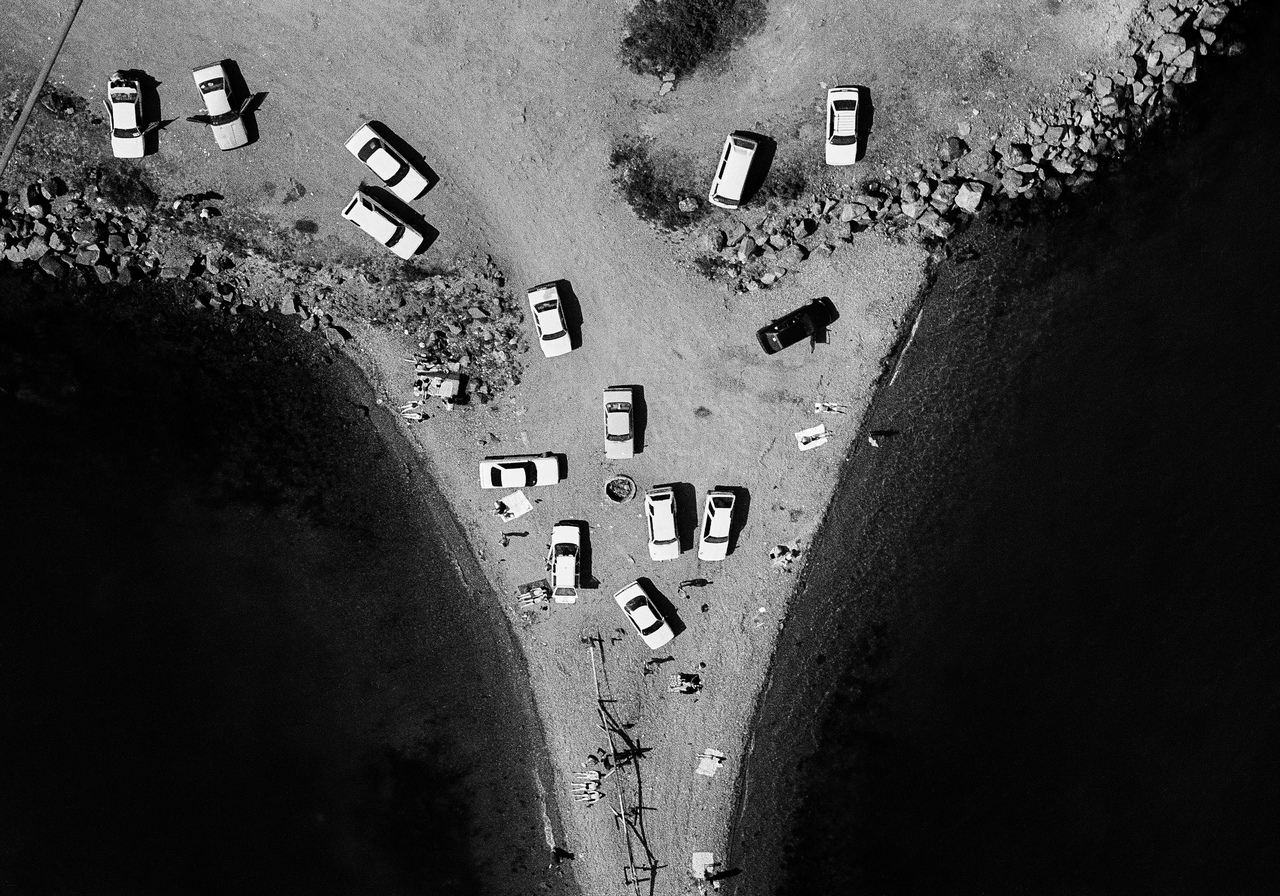
NOVEMBER 15, 2019 – MAY 17, 2020 / MAIN EXHIBITION HALL
On November 15, the Zarya Center for Contemporary Art will open the exhibition “Far Focus. Photographers of Vladivostok,” which includes approximately 400 photographs of Vladivostok from the 1970s until the present. The project is the first to offer such a sweeping retrospective alongside the cutting edge of contemporary photography in the city.
“Many regional photography schools – from Petersburg, to Kazan, to Novokuznetsk – have been shown in Russia in exhibitions or printed in albums and catalogues,” explains ZARYA CCA Chief Curator, Alisa Bagdonaite. “At the same time, in many cities and even entire regions, photographic practice remains almost undetectable or too little known in Russia and the world. ‘Far Focus’ is our attempt to use the medium of photography to understand and represent what it means to live in Primorye, and how Vladivostok artists and reporters look at their home.”
The photographs presented in this exhibition capture life in the big city and its surrounding countryside, exploring different methods and means of “looking at” reality and manipulating images.
“The project ‘Far Focus’ has turned out to be quite an important experience for me,” explains curator Anna Petrova. “During my curatorial residency and through conversations with photographers, artists, gallerists and museum professionals while in residence in Vladivostok, I managed to build up a sizable database of contacts, as well as assemble an archive of photographs. This material was so unexpected and interesting, both formally and from an anthropological point of view.”
Zarya’s eight galleries will feature the broad diversity of genres and regimes of looking engaged by the photographers of Vladivostok: from the “portraits of industry” and the landscapes of the Far East, to architectural shots and artistic experiments. The portrait remains the most popular genre for photography, offering a tool to represent others, whole classes and strata of society, and, at the same time, also find and discover yourself. Georgy Khrushchev’s photographs of the factory Dalpribor, reportage by Alexander Khitrov, and Gleb Teleshov’s series fix on images of labor and minority communities. In works by Ivan Speransky, Alexey Korotkov, and Vladimir Shutafedov, commercial and fashion photography alternates with documentary chronicles from sites of labor, and the usual models are replaced by circus jugglers and acrobats, cobblers and shoemakers.
The urban landscape of Vladivostok is reconstructed through the panoramas and architectural shots of Elena and Alexander Melnikov, while the massive residential blocks built during the eras of Khrushchev and Brezhnev tap into an unexpected poetic dimension in the pictures of Sergey Orlov.
The collective body of the city and its group identity are explored in a section on “Holidays and Rituals,” which includes the Shrovetide rituals of Maslenitsa and May 1, Communist rallies and religious processions. These celebrations catalogue a range of moods and means of communicating, from strictly regulated, to spontaneous, to utterly unbound.
Often staged or experimenting with techniques of shooting, developing or printing, artistic photographs form the crux of the thematic and conceptual series by Mikhail Pavin. The ideals of nonconformism and alternative perspectives are developed in the frames of Sergey Drobnokhod and Sergey Kiryanov. A separate section of the exhibition is dedicated to images taken by smartphones, snatching fragments of “faces and places,” looks and gestures, color and textures, bringing life in the city even closer to the observer, the flâneur and the viewer. In this field of “street photography” you find Denis Korobov, Maria Babkova and Instagrammers Pavel Nemtin and Leonid Zvegintsev.
In total, the exhibition includes works from 19 photographers: Maria Babkova, Sergey Drobnokhod, Alexander Khitrov, Georgy Khryshchev, Sergey Kiryanov, Evgenia Kokurina, Denis Korobov, Alexey Korotkov, Yury Lugansky, Elena and Alexander Melnikov, Pavel Nemtim, Sergey Orlov, Mikhail Pavin, Vladimir Shutafedov, Ivan Speransky, Gleb Teleshov, Yury Yarotsky and Leonid Zvegintsev.
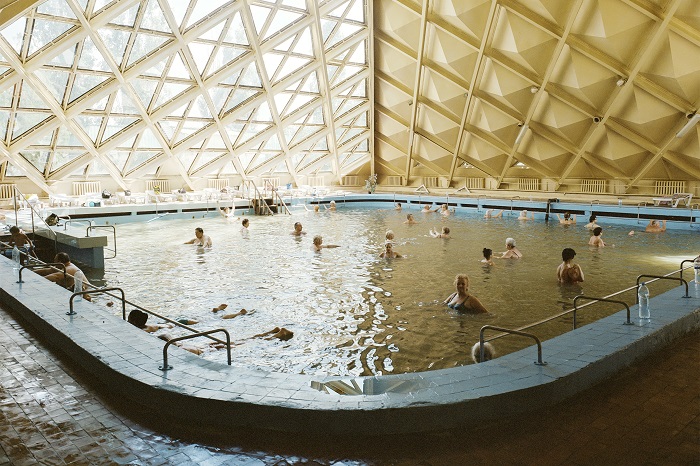
NOVEMBER 15, 2019 – JANUARY 12, 2020 / SMALL EXHIBITION HALL
On November 15, the Zarya Center for Contemporary Art will open the exhibition of photographs “Water Architecture: The Experience of Immersion,” which will transport viewers to the world of the resorts and health spas of the Soviet Union and Russia, including Primorye.
Curated by Anna Petrova, “Water Architecture: The Experience of Immersion” brings together photographs of two different epochs – the Soviet and Post-Soviet. On view will be the works of the father and son duo, Michael and Igor Churakov, Claudine Doury, René Fietzek, Olya Ivanova, Georgy Khrushchev, Daniel Kolchanov, Dmitry Lookianov, Ivan Mikhalov, Igor Mukhin, Egor Rogalev, alongside Michal Solarski, and Anatoly Topuz.
In the Soviet Union, sanatoriums, resorts, and spas took over the former residences and palaces of the tsars. A few were built in the 1930s, leading to a mix of both avant-garde and neoclassical. After World War II, recreational architecture – both buildings for cultural recreation and the care of one’s health – was designed by Modernist architects, whose no-frills approach relied instead on innovative (often to the point of bordering on the absurd) forms.
Back then all these new structures were captured in photographs: father and son, Michael and Igor Churakov, whose archive is today part of the collection of the Shchusev Museum of Architecture, traveled around the far corners of the country, photographing residential housing and administrative buildings. The reporter Anataly Topuz, meanwhile, canvassed the health centers: his color photographs of physiotherapy bear witness to the technical equipment in these facilities, while tapping into the almost surreal atmosphere of the medical interventions into the organisms of Soviet citizens.
In today’s capitalist society, the legacy of the Soviet sanatoriums seems to offer an oasis of prosperity. Having researched the system of the recreational industry in the USSR, British journalist Maryam Omidi produced a book with photographs of health resorts in Russia and Belarus, the Crimea and the Caucasus, Central Asia and the Baltics. Many of the photographers she enlisted to document her case studies took the initiative to continue the research around these spas themselves.
It is this body of photographs that constitute the bulk of the second chapter of our exhibition. Claudine Doury, René Fietzek, Michal Solarski, Dmitry Lookianov, Olya Ivanova and Egor Rogalev contribute images both of modernist architecture, with its trademark silhouettes and interiors, and the moods and expressions on the faces of the people undergoing the physiotherapeutic treatments. Relaxed or concentrated, enduring their discomfort or just plain passed out, the protagonists in these photos are of interest, both aesthetically and anthropologically.
Another chapter of the exhibition focuses on the “Water Architecture” of Primorye, Caucasus, Moscow and the Volga. Selected photographs from Igor Mukhin’s series “Week-end,” Olya Ivanova’s portraits of women at the legendary Chaika, an open-air swimming pool in the center of Moscow, Ivan Mikhailov’s shots from the shores of the Volga in Cheboksary and the bedroom communities of the Moscow River, Georgy Khrushchev’s coverage of the Primorsky “walruses”, and the “shameless bathers” of Pyatigorsk, captured by Dmitry Kolchanov, all build off of the theme, demonstrating natural architectonics, whether holes in the ice or pools amid the rocks, wild beaches or piers.
Egor Rogalev forges a different narrative through his project Oceanization, which explores the resorts and Pioneer camps of Vladivostok. The two-channel video installation draws from archival materials and slides gathered during Rogalev’s time in the Zarya Artist-in-Residency program. The piece examines the complex relationship between the architecture of Vladivostok and the particular features of the landscape, the geological topography and the climate, which it then sets in contrast against two opposing tendencies: the inert desire to neutralize and control outside influences and the poetic quest for more open and expressive means of interacting with the environment.
Images of mud, caves, hot springs, oxygen baths, therapeutic exercises, vertical tanning beds and salt rooms immerse the user (and the viewer) into another reality, making summer vacations such a pleasant experience. Whether taken on its surface or understood more metaphorically, “Water Architecture” borders on the surrealist and the absurd, deeply immersing its viewer in the sensations of holiday-makers and vacationers, designing and building, swimming and diving.
This project was made possible through loans of photographs from the archives of the Shchusev State Museum of Architecture and the collection of Sergey Shestakov (@ussr.photo).
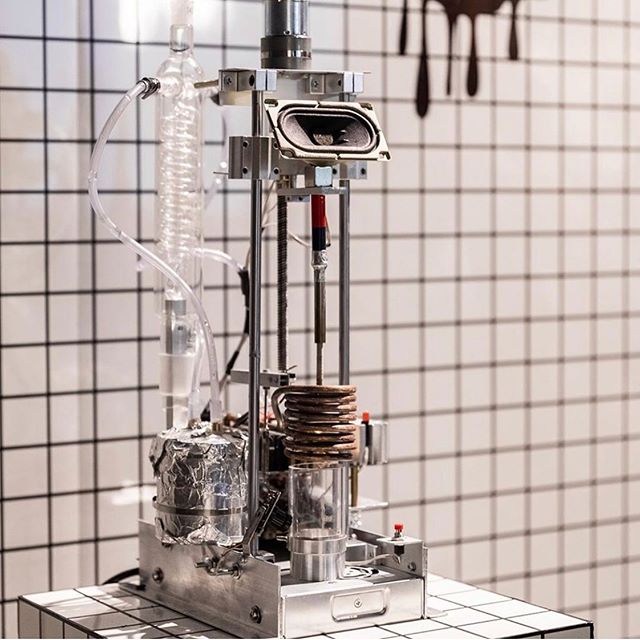
OCTOBER 5 – NOVEMBER 4 / SMALL EXHIBITION HAL
On October 5, the Zarya Center for Contemporary Art will open the multimedia installation, Guest, by one of the most world-renowned Russian artists working in the field of science-art, Dmitry Morozov, better known by his pseudonym, ::vtol::.
Morozov's practice explores sound, light, society, the internet and all the possible means man has of mastering the world around him. In Vladivostok, the artist will present a kinetic, electromagnetic sound installation, dedicated to the Sikhote-Alin meteorite, which fell in the Far East in 1947 According to the artist's concept, the cyclical system models the moment the meteorite “arrived” on earth – an extremely elusive and rare event.
As the artist explains, “The main impetus and inspiration leading me to the creation of this work was the addition to my geological collection of a few individual fragments of the Sikhote-Alin meteorite, which landed in the Far East in 1947 This meteorite was unique for a number of reasons. For starters, it was the largest iron meteorite in recent history. Witnesses of its descent were myriad, including the artist Petr Medvedev, who was painting en plein air at the time of the fall and was able to capture his experience on canvas. The resulting painting was very popular in the USSR. This is the most studied of any of the objects that have ever fallen to the earth, and yet tiny shards and individual fragments can still be found around the point of impact.”
“The unbelievable allure of these rarest of ‘guests’ from the cosmos immediately inspired me to develop an artistic research project, involving some of what I find the most interesting trends in the sphere of technological art: natural and artificial electromagnetism, work with sound, robotic automatized systems, geology and astrophysics. Each of these aspects are not only a means for reaching a unified artistic expression, but also a powerful medium, in and of themselves, forming a synergy of individual elements within the work. The realization of this work is not limited to the creation of the object itself, but also includes taking the piece to the Meteorite Village, not far from the site of impact in the hills of Sikhote-Alin.”
“The culmination of the project is the setup of a functioning installation in one of the craters left from the crash of the pieces of meteorite fragments. This offers its own means of recreating the moment of impact directly on the spot where the meteorite hit the earth. This kind of journey can rightly be thought of as a pilgrimage/research trip, together alongside the filming of a short documentary film dedicated to the whole process.”
Dmitry Morozov (born 1986, Moscow) realizes his artistic ideas through technological genres like robotics, sound art, and science art, exploring the themes of chaos and self- organizing systems, and analyzing social, biological and physical phenomena. The artist also designs and creates experimental musical instruments and modular synthesizers. He has participated in the 4th Moscow Biennale of Contemporary Art, the Archstroyanie Festival, The Night of New Media, CTM/Transmediale (Germany) and Ars Electronica (Austria.) His works have been exhibited at leading institutions for contemporary art, including the NCCA (his solo exhibition “Interface of the Ongoing,” was on view through September 29), MMOMA, Manezh, the State Hermitage Museum, Laboratoria Art&Science Space, Electromuseum, the Polytechnical Museum, the Garage Museum of Contemporary Art, ZKM Zentrum (Germany), the Boulder Museum of Contemporary Art (USA), and the National Taiwan Museum of Fine Arts (Taiwan). He was previously featured in Vladivostok in the group exhibition “Misadventures of Discovering” at the Hlebozavod Center for Contemporary Culture. He is the award winner of the Sergei Kuryokhin Prize (2013), Prix Cube (France, 2014) and also received honorary mentions at VIDA 16 (Spain, 2014) and Prix Ars Electronica (Austria, 2015, 2017).
This work was produced with funding from a grant from NOVA ART, received as part of the NOVA ART CONTEST.

The Zarya Center for Contemporary Art will show a selection of works from its collection, built up over the past 5 years of the artist residency program.
Since the moment it launched in December 2014, the Zarya artist-in-residence program has welcomed artists from 17 countries to realize more than 80 proposals, dedicated to rethinking the local geopolitical, social and cultural landscape. On March 2, the Zarya Center for Contemporary Art will open the exhibition “IN RESIDENCE: From the Collection of Zarya Center for Contemporary Art,” which selects from the creative proposals and art works created by artists during their residencies.
Throughout its tenure, the Zarya Center for Contemporary Art has seen its mission as increasing Vladivostok’s significance as a point on the map where creative life is flourishing. Zarya strives to serve as an independent platform for creative production and a professional dialogue about art. The artist residency program has become a key instrument for attaining those goals. Thanks to the open format of the residency, Zarya has managed to bring together the resources of many artists and researchers to unpack the manifestation of the local landscape within the discourse of contemporary art. Among those who have participated in the residency and whose works will be on display in this exhibition are Dmitry Bulnygin, Irina Zatulovskaya, Olga Kroitor, Sergey Shutov, Hong Jinhwon (South Korea), Fabian Knecht (Germany), Elizaveta Konovalova (Russia, France), Alexander Morozov, Natalya Pershina-Yakimanskaya (Glukyla) (Russia, the Netherlands), Elena Redaelii (Italy), Ма Haijiao (China), Sarah Hillebrecht (Germany), Sarawut Chutiwongpeti (Thailand), the collective, Searching Utopia (Finland) and many others.
The first exhibition from the Zarya collection gathers works that are dedicated to the Primorsky Krai in one space in order to forge new links between the artistic approaches of the residents to the study of the territory, culminating in the creation of a new “portrait of the place.” The perspectives from which the artists consider Vladivostok and the Primorsky Krai are not just aesthetic; in their projects, the artists raise many important social, historical and ethical questions. Among the selections are works reflecting on the theme of the specific features of the region’s natural landscape, the history and memory of the Gulag, the history of the Zarya factory and the women who once worked the sewing machines, the contemporary urban environment and social boundaries.
The presentation of this collection results not only in the spectacular display of the results of five years of work, but also in a means to evaluate those results critically. The audience can get to know this portrait of Primorye, created by Russian and international artists alike, up until May 26.
Exhibition Curators: Alisa Bagdonaite, Andrey Vasilenko, Adel Kim
Participating Artists:
Dmitry Bulnygin (Russia), Sarawut Chutiwongpeti (Thailand), Tatyana Efrussi (Russia, France), EVOL (Germany), Alexander Florensky (Russia), Olga Florenskaya (Russia), Ма Haijiao (China), Leif Holmstrand (Sweden), Sarah Hillebrecht (Germany), Hong Jinhwon (South Korea), Fabian Knecht (Germany), Elizaveta Konovalova (Russia, France), Olga Kroitor (Russia), Sasha Kurmaz (Ukraine), Lyokha G. (Russia), Alexander Morozov (Russia), Anastasia Potemkina (Russia), Natalya Pershina-Yakimanskaya (Glukyla) (Russia, the Netherlands), Elena Redaelii (Italy), SASHAPASHA (Russia, Finland), Sergey Shutov (Russia), Anastasia Tsayder (Russia), Mikhail Zaikanov (Russia), Searching Utopia (Finland), Irina Zatulovskaya (Russia).
%20-%20%D0%BA%D0%BE%D0%BF%D0%B8%D1%8F.jpg)
SEPTEMBER, 3 – OCTOBER, 1 / SMALL EXHIBITION HAL
Andrey Dmitrenko's latest exhibition takes its name from lyric poetry. In the Russian version of the title, the use of the informal personal pronoun “you” connotes a certain proximity, and even intimacy to the subject, but the addressee itself remains unknown.
“You” could be the viewer, who navigates the exhibition, slipping into contemplation and losing themselves for a moment, only to be brought back by the sound of their own footsteps.
“You” could be the work, which always brings its own intonations and “noise” into the space around it.
The artist prefers to work in mixed media, contrasting the textures and characteristics of various materials, from metal, to textiles, to paper. And these contrasts always have a moment of chance about them: it is never exactly clear where the artist’s hand has intervened, and what are just the natural properties of the material. In any case, with his interventions the artist emphasizes these properties, making them resonate, until that they literally become “noise.” The viewer is then called upon to continue the artist’s process through their contemplation of the work.
The transitions from one material to another can also be seen as a means to shift from seeing to listening. Sound is one of the main components in Dmitrenko’s works. The viewer might see the fragments of striped fabrics used in some of the artist’s canvases and connect them to his or her own experiences and memories of bedsheets. In this sense, the artist “activates” a kind of sleep mode, like the curious phenomenon when one is dreaming, and auditory sensations trigger images.
The dimensions of the works are often not very large. They do not presume to completely take up the space. Their status is never clear: on the one hand, they are, of course, images, but on the other, they are objects with an unknown origin and an undefined function. They do not impose themselves on the viewer, who must still discover them, recognizing them as works of art and locating them within “this little landscape.” If we think about the function, then Dmitrenko’s works are like tuning forks – instruments for measuring the intensity of sound in an enclosed space.
With their horizon lines and two or three planes, the suite of works from the “Storm” series can be considered as landscapes – albeit, very unstable and provisional landscapes. All the fits and fury of their internal storms seem either to have already passed, or, conversely, to constitute the very substance of the storm, not in the visual sense, but in terms of the intensity of the experiences.
If we are to speak of tradition, then the works of Andrey Dmitrenko pick up on the history of music within minimalism – the experiences of organizing sounds of different origins, as well as integrating these sounds into a musical fabric.
Kirill Svetlyakov

JUNE, 22 – SEPTEMBER, 1 / SMALL EXHIBITION HALL
Morskaya group art exhibition will open June, 22 at Zarya Center for Contemporary Art as a part of the international V-ROX EXPO festival. Titled after the legendary first album by Mumiy Troll band, it features 28 artists, selected by the show curator – Moscow-based artist Dmitri Aske, the V-ROX EXPO organizing committee and representatives of Zarya CCA.
'Morskaya' art show is paintings and graphics, installations, photos, spacial sculptures – they all, just like many songs by Mummiy Troll, embody spirit of the Russian Far East. Most of the artists are based in Vladivostok – that's why a can of ‘Milkis’ in their works fits right in, peonies consist of shells, and a seagull made of mosaics looks so arrogant. Photos of landscape show the less obvious and touristic of Vladivostok spots, offering a personal, insider’s look at the city; the sound for interactive installation 'Listen To The Sea' was recorded in a very specific location, too – Shamora beach. ‘Portrait of a Captain’ is a collective image of all things that make a true seadog – or the way people tend to think of them. It is yet to be proven if Vladivostok offers winter surfing, but the Far Eastern artists found an honorable place for it in their works, just like for the sea – Vladivostok’s most formative site.
Ilya Lagutenko, V-ROX EXPO curator: “V-ROX EXPO is a laboratory of creative ideas, an opportunity to not only introduce new music to the city but to get people involved in a cultural dialogue. Morskaya was conceived first and foremost for Far Eastern artists. I sincerely wish for Vladivostok to become a permanent artistic pot where all kinds of creative ideas bear fruit in new projects, uniting people, expanding opportunities, and offering a glimpse over the horizon”.
Dmitri Aske, Morskaya exhibition curator: “For the exhibition we selected works that fit within the given theme and represent a wide array of techniques and styles employed by Far Eastern artists. I was curious to see all the submitted works, to get an idea of what people create in this region. I hope that the art show and V-ROX EXPO as a whole, will be able to inspire people and get creative energy flowing, in one way or another. This is exactly what I am hoping for myself for this trip to Vladivostok”.
Specially for V-ROX EXPO Aske will deck Zarya CCA with his ‘Turning Point’ – a piece on inner stuggles and hardships of choosing a way when facing important life decisions.
Morskaya Artists
Vladivostok: Dmitrii Chovgan, Andrey Chugunov, Andrey Dmitrenko, Irina Drobot, Alexandra Epstein, Vladimir Ershov, Vasiliy Galaktionov, Lekha Gominid, Lesya Ilyonok in cooperation with Julia Sufianova and Daria Litvinenko, Ilya Kantakov, Kirill Kryuchkov, Masha Lamzina, Maksim Listopadskiy, Dmitriy Luchinin, Appolinaria Ravnoapostolnaya, Daniil Sakharov, Pavel Shapovalov, Viktoria Sharmankina, Tatiana Silverstova and Alvina Verner.
They will be joined by artists from Khabarovsk (Yana Jan-Sha, Adele Sakhnevich, Yaroslava Verner), Moscow (Anna Lyalina), Ussuriisk (Evgeniy Korotkov) and Fokino (Natalia Khristenko).

22 июня в Центре современного искусства «Заря» в рамках фестиваля V-ROX EXPO откроется коллективная выставка «Морская». За два месяца поступило множество заявок с проектами, объединенными темой «Морская» – по названию альбома группы Мумий Тролль. В итоговую экспозицию были отобраны работы 28 авторов.
Это художники из Владивостока: Dmitrii Chovgan, Irina Drobot, Альвина Вернер, Василий Галактионов, Леха Гоминид, Андрей Дмитренко, Владимир Ершов, Леся Ильенок в соавторстве с Юлей Суфьяновой и Дарьей Литвиненко, Илья Кантаков, Кирилл Крючков, Маша Ламзина, Максим Листопадский, Дмитрий Лучинин, Апполинария Равноапостольная, Данил Сахаров, Татьяна Сильверстова, Андрей Чугунов, Павел Шаповалов, Виктория Шарманкина и Александра Эпштейн.
Кроме того, в выставке примут участие авторы из Хабаровска (Ярослава Вернер, Яна Джан-Ша, Адель Сахневич), Анна Лялина из Москвы, Евгений Коротков из Уссурийска и Наталья Христенко из города Фокино.
Мы поздравляем всех художников и благодарим за то, что они откликнулись, ждем на открытии!
Изображение: «Зимний серфинг», Александра Эпштейн (Владивосток).
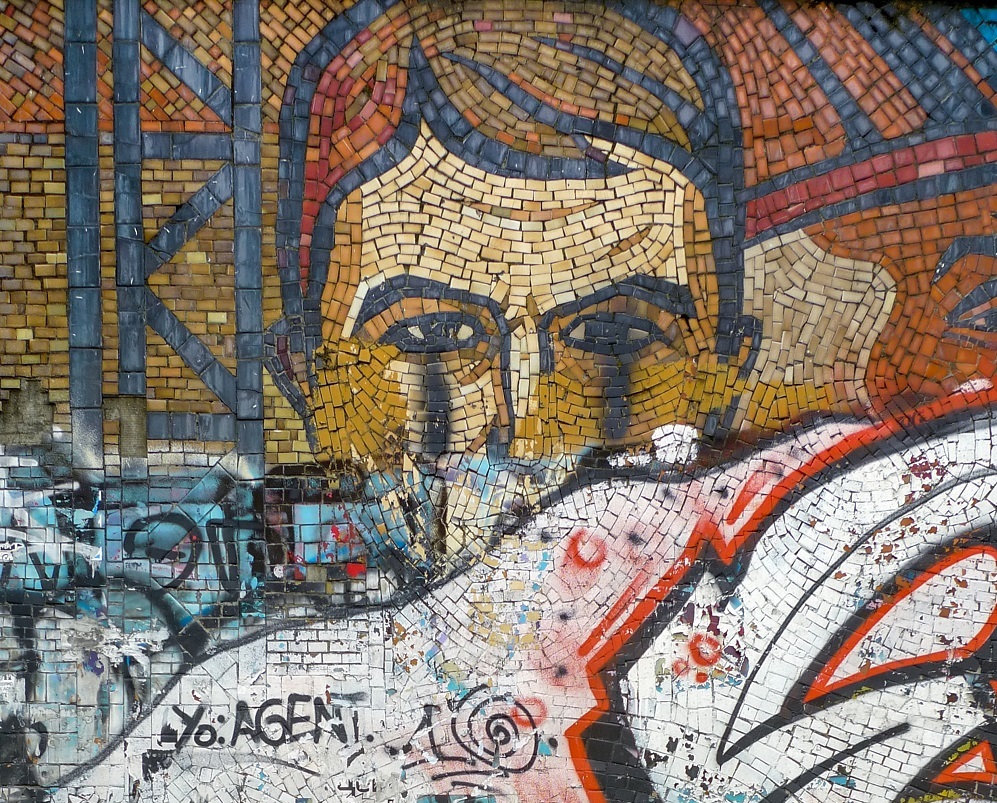
1–16 JUNE / SMALL EXHIBITION HALL
VERNISSAGE: 1 JUNE / 17:00
The Zarya Center for Contemporary Art presents a new exhibition dedicated to Vladivostok and its main components, deconstructing and reconstituting the theme of the city through different media, including documentary photography, painting and sculptural objects.
The morphology of Vladivostok seems to come down to three basic components: shrubbery and trees; walls of brick, concrete or plastic; and cars – specifically those of Asian origin. The stark contrast between the natural, the architectural and the technological is what distinguishes this “city of the triumphant motorist” in the Russian urban landscape. The photographic mini-catalogue presents the formula for typical city views according to the scheme of “tree-wall-car,” laying bare the mechanisms of the formation of both the urban environment and our perception of it.
A different type of urban “wall” can be found in the three mosaic stelae on Kalinina street, courtesy of artists Alexey Onufrienko and Anatoly Katsuk. Commissioned in 1980 by Viktor Lomakin, the First Secretary of the Primorsky Krai’s Communist Party, these monumental panels were dedicated to the workers of Primorye: the sailers, the builders, the fishermen. Today these monuments of Late Soviet Modernism are in a state of decay, with crumbling smalt and a bare concrete brick foundation, witness to the dying and shedding of the next “cultural” layer: graffiti.
Within the exhibition space, paintings stand in for urban flora, as the abstract yellow-green-pink compositions of Pavel Shukupov, a member of the artist’s association “33+1”, are layered into the crown of a large tree. Appearing like “nails” of the exhibition are objects fashioned from the expendable materials from the tire shops “decorating” the whole city but today viewed as undesirable exiles (it is now prohibited to use these rubber products in city courtyards). In this way, the urban fabric of the Primorye’s capital city accumulates into a complex puzzle, a layer cake of historical meanings and their obsolescence, initiatives and indifference, daily needs and adaptations, nature and civilization.
Members: Anya Petrova, Pavel Shukupov
FREE ADMISSION
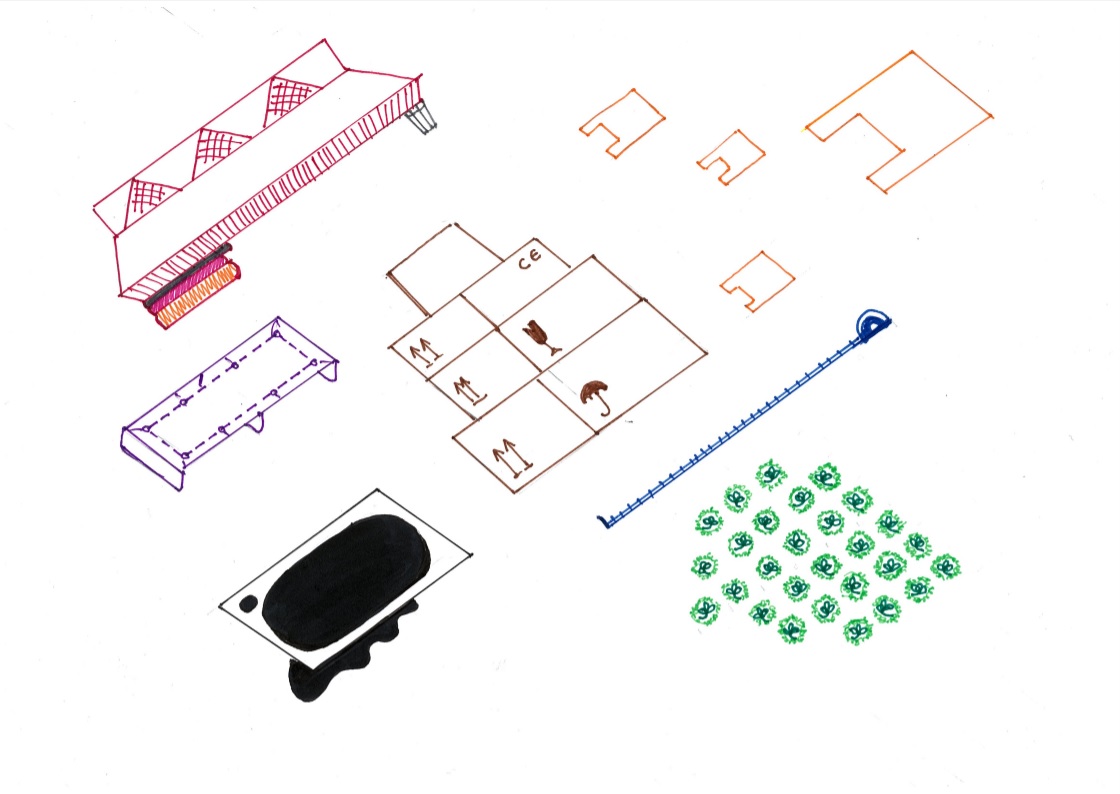
10-12 МАЯ / ЧИТАЛЬНЫЙ ЗАЛ / 12+
ВЕРНИСАЖ: 10 МАЯ / 19:00
Очередное взаимодействие участников Владивостокской школы современного искусства результирует в тотальную инсталляцию, демонстрирующую коллективное художественное высказывание на тему современности как таковой, при котором совместно делится (и проживается) настоящее время. Восприятие этого настоящего как категории не только временной, но и топологической, формирует наше отношение к месту, в котором мы находимся. Для визуализации феномена был выбран образ съёмного жилья как транзитного модуса, в котором сосуществуют не только студенты и резиденты открытого порта Владивосток, но и люди работоспособного возраста большинства крупных городов мира. Поводом для исследования темы служит как частный опыт людей из окружения участников ВШСИ, многие из которых живут в съёмных квартирах большую часть сознательной жизни, так и история самой школы современного искусства – объединения, которое уже четыре года существует во Владивостоке без фиксированного официального помещения и в своей выставочной практике часто обращается к формату квартирника.
Посетителю инсталляции предложат порассуждать о том, что такое «дом» или «свое место» в наше время сокращенного настоящего, и как следы чужого пребывания и диктатура старой мебели становятся самостоятельными акторами. Предметы быта в наших квартирах, которыми мы никогда не обладаем до конца, и домашние ритуалы ставят нас в невидимые сетевые отношения, а помещенные в выставочное пространство, они, через ощущение моментального (и сентиментального) узнавания, связывают зрителя с его повседневным опытом, давая возможность произведению художников в очередной раз стереть границу между обыденностью и сакральностью. Самостоятельная жизнь вещей, постоянная отсрочка ремонта в сдаваемой квартире, накопительство и фиксация в прошлом, отношения власти и подчинения в коллективном сожительстве, окружение себя материальными символами стабильности, невольный вуайеризм и свидетельствование соседской интимной жизни – лишь некоторые смысловые якоря инсталляции.
Жили-проживали: Кристина Александрова, Женя Барабаш, Яна Гапоненко, Марина Давидович, Денис Ерастов, Анастасия Есауленко, Елизавета Кириллова, Кирилл Крючков, Татьяна Нельмина, Сергей Цынгунов, Олеся Чернявская, Катя Шрамко.
ВХОД СВОБОДНЫЙ

2 MARCH – 26 MAY / SMALL HALL
On the first day of Spring, Zarya Center for Contemporary Art will present “The Rites of Spring,” an interactive project from the Vladivostok punk-romantic collective, DVR – Dalnevostochnye Razluchnitsy (“Homewreckers of the Far East”.)
Founded in Vladivostok in 2016, over the course of its existence the group has developed a synthetic practice, combining music, poetry, sound, performance and actions. DVR’s performances have taken place in museums, clubs, house parties, garages, city streets and an aquarium. Each performance is held in collaboration with poets, artists, musicians and even strangers, who find themselves temporarily becoming a “homewrecker.” With this kind of fluid composition, the group creates a stream of hybrid ecstatic acts.
For DVR, the key narrative instrument is the aesthetics of collaboration. The main stylistic feature of their works is the fluidity of the process, an accent on the “here and now” without relying on a story, a precise script or finished form. This is why the exhibition begins with a blank page in an empty space, which will gradually fill with events, new connections, artifacts, and myths. Communication within this micro-community will take the form of public discussion, involving any interested audience members in the creation of the project, making them an integral part of what’s going on.
Another defining feature of “The Rites of Spring” is its cyclical structure. The exhibition breathes like a living organism, changing from cycle to cycle. Each cycle is ushered in with a preparation period, an event and an exhibition within the exhibition, in which the exponents are the traces of the past event. After this, a new cycle begins, keeping to the same approximate script. Audience participation – whether intentional or spontaneous – is obligatory.
Instead of working with traditional exhibition formats, the artists plan to create an experimental operetta, encouraging the audience to abandon the role of the passive observer and join the fray. In this way, “The Rites of Spring” is designed as a call to arms for all those in the spheres of play, art and music, inviting them to become a Homewrecker of the Far East.